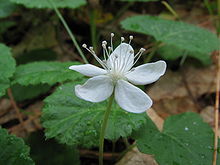Dalibarda
| Dalibarda | |
|---|---|
 |
|
| Foliage and flower | |
| Scientific classification | |
| Kingdom: | Plantae |
| (unranked): | Angiosperms |
| (unranked): | Eudicots |
| (unranked): | Rosids |
| Order: | Rosales |
| Family: | Rosaceae |
| Genus: |
Dalibarda L. |
| Species: | D. repens |
| Binomial name | |
|
Dalibarda repens L. 1753 |
|
| Synonyms | |
|
|
Dalibarda repens (dewdrop, false violet, star violet, Robin runaway. French Canadian: dalibarde rampante) is a perennial plant (a forb) in the rose family, native to eastern and central Canada and to the northeastern and north-central United States. It is the only species in the genus Dalibarda, which is closely allied with the genus Rubus (brambles, blackberries, raspberries). The species is often included in the genus Rubus as Rubus repens (L.) Kuntze. It is fairly easily grown in shady locations in damp to wet, acidic soils, and is frequently used in wildflower and bog gardens as a ground-cover.
Dalibarda repens is a herbaceous plant with simple leaves, and hairy stems. It is the only species in the genus Dalibarda. It has both sterile and fertile flowers. The sterile flowers are much less numerous than the fertile ones, have five white petals and are borne atop a peduncle. The more numerous fertile flowers are cleistogamous (they are self-pollinating and never open), and are hidden beneath the leaves. The flower stalks (peduncles) of the cleistogamous flowers are short, 2–5 cm long, and curved downward. The calyx forms a shallow, hairy hypanthium, which is divided into 5–6 lobes of unequal size, the 3 larger lobes are toothed (serrate).
The stem is decumbent/creeping, "several inches" in length, with a densely tufted terminal portion which bears both leaves and flowers.
The leaves are basal, simple, pinnately veined above the base, long-petiolate, and slightly hairy/downy on both sides. They are dark green in color. Leaf blades cordate to rounded (orbicular), 3–5 cm long; the basal lobes are rounded; the apex is blunt to rounded; the margins are scalloped, with low rounded teeth (crenate); and the petioles are hairy, 3–10 cm long.
The common name false violet comes not only from the heart-shaped leaves, but also because this plant, like violets, produces two kinds of flowers.
Though this plant is globally secure, it is locally endangered in Connecticut, New Jersey, North Carolina and Rhode Island. It is listed as threatened in Michigan and Ohio.
The plant can be identified as being low, spreading by runners with leaves and flowers arising on separate stalks from the runner. The sterile flowers are white with 5 broad petals and numerous long stamens, solitary on a long, reddish flower stalk arising from runner. Leaves are kidney-shaped, with a long petiole, and with outer margin scalloped. The plant os 2 to 5 inches in height.
...
Wikipedia
